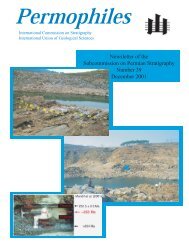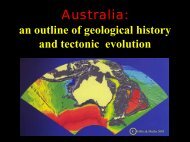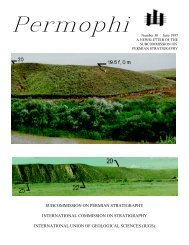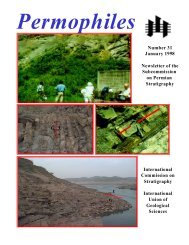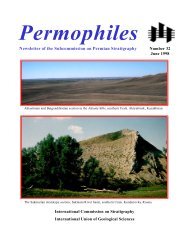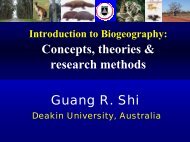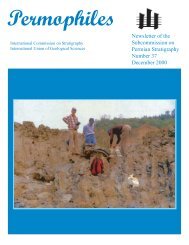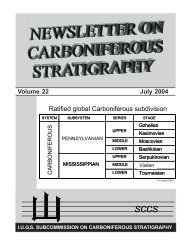Newsletter of the Subcommission on Permian Stratigraphy Number 46
Newsletter of the Subcommission on Permian Stratigraphy Number 46
Newsletter of the Subcommission on Permian Stratigraphy Number 46
Create successful ePaper yourself
Turn your PDF publications into a flip-book with our unique Google optimized e-Paper software.
SUBMISSION GUIDELINES<br />
FOR ISSUE 47<br />
It is best to submit manuscripts as attachments to E-mail messages.<br />
Please send messages and manuscripts to my E-mail addresses;<br />
hard copies by regular mail do not need to be sent unless<br />
requested. Please <strong>on</strong>ly send a single versi<strong>on</strong> by E-mail or in <str<strong>on</strong>g>the</str<strong>on</strong>g><br />
mail; if you discover correcti<strong>on</strong>s before <str<strong>on</strong>g>the</str<strong>on</strong>g> deadline, <str<strong>on</strong>g>the</str<strong>on</strong>g>n you<br />
may resubmit, but indicate <str<strong>on</strong>g>the</str<strong>on</strong>g> file name <str<strong>on</strong>g>of</str<strong>on</strong>g> <str<strong>on</strong>g>the</str<strong>on</strong>g> previous versi<strong>on</strong><br />
that should be deleted. Manuscripts may also be sent to <str<strong>on</strong>g>the</str<strong>on</strong>g> address<br />
below <strong>on</strong> diskettes prepared with a recent versi<strong>on</strong> <str<strong>on</strong>g>of</str<strong>on</strong>g><br />
WordPerfect or Micros<str<strong>on</strong>g>of</str<strong>on</strong>g>t Word; printed hard copies should accompany<br />
<str<strong>on</strong>g>the</str<strong>on</strong>g> diskettes. Word processing files should have no<br />
pers<strong>on</strong>alized f<strong>on</strong>ts or o<str<strong>on</strong>g>the</str<strong>on</strong>g>r code and should be prepared in single<br />
column format. Specific and generic names should be italicized.<br />
Please refer to this issues <str<strong>on</strong>g>of</str<strong>on</strong>g> Permophiles (e.g. Nurgalieva et al.)<br />
for reference style, format, etc. Maps and o<str<strong>on</strong>g>the</str<strong>on</strong>g>r illustrati<strong>on</strong>s are<br />
acceptable in tiff, jpeg, eps, bitmap format or as CorelDraw or<br />
Adobe Illustrator files. The preferred formats for Adobe Pagemaker<br />
are Micros<str<strong>on</strong>g>of</str<strong>on</strong>g>t Word documents and bitmap images. We use Times<br />
Roman 12 pt. bold for title and author and 10 pt. (regular) for<br />
addresses and text (you should too!). Please provide your E-mail<br />
addresess in your affiliati<strong>on</strong>. Indents for paragraphs are 0.20 inch;<br />
do not use your spacebar. Word processing documents may include<br />
figures embedded at <str<strong>on</strong>g>the</str<strong>on</strong>g> end <str<strong>on</strong>g>of</str<strong>on</strong>g> <str<strong>on</strong>g>the</str<strong>on</strong>g> text, but <str<strong>on</strong>g>the</str<strong>on</strong>g>se figures<br />
should also be attached as separate attachments as bitmaps or as<br />
CorelDraw or Adobe Illustrator files. Do not include figure capti<strong>on</strong>s<br />
as part <str<strong>on</strong>g>of</str<strong>on</strong>g> <str<strong>on</strong>g>the</str<strong>on</strong>g> image; include <str<strong>on</strong>g>the</str<strong>on</strong>g> capti<strong>on</strong>s as a separate<br />
secti<strong>on</strong> within <str<strong>on</strong>g>the</str<strong>on</strong>g> text porti<strong>on</strong> <str<strong>on</strong>g>of</str<strong>on</strong>g> <str<strong>on</strong>g>the</str<strong>on</strong>g> document. If <strong>on</strong>ly hard copies<br />
are sent, <str<strong>on</strong>g>the</str<strong>on</strong>g>se must be camera-ready, i.e., clean copies, ready<br />
for publicati<strong>on</strong>. Typewritten c<strong>on</strong>tributi<strong>on</strong>s are no l<strong>on</strong>ger acceptable.<br />
All <str<strong>on</strong>g>the</str<strong>on</strong>g> c<strong>on</strong>tributors must provide electr<strong>on</strong>ic versi<strong>on</strong>s <str<strong>on</strong>g>of</str<strong>on</strong>g> your<br />
text and elctr<strong>on</strong>ic or camera-ready hard copies <str<strong>on</strong>g>of</str<strong>on</strong>g> figures.<br />
Please note that we prefer not to publish articles with names <str<strong>on</strong>g>of</str<strong>on</strong>g><br />
new taxa in Permophiles. Readers are asked to refer <str<strong>on</strong>g>the</str<strong>on</strong>g> rules <str<strong>on</strong>g>of</str<strong>on</strong>g> <str<strong>on</strong>g>the</str<strong>on</strong>g><br />
ICZN. All manuscripts will be edited for c<strong>on</strong>sistent use <str<strong>on</strong>g>of</str<strong>on</strong>g> English<br />
<strong>on</strong>ly.<br />
I currently use a Windows 2000 PC with Corel Draw 12, Adobe<br />
Page Maker 7.0, Adobe Photoshop 7 and Micros<str<strong>on</strong>g>of</str<strong>on</strong>g>t Office programs;<br />
documents compatible with <str<strong>on</strong>g>the</str<strong>on</strong>g>se specificati<strong>on</strong>s will be<br />
easiest to work with.<br />
E-mail: szshen@nigpas.ac.cn<br />
shen_shuzh<strong>on</strong>g@yahoo.com<br />
Mailing address:<br />
Pr<str<strong>on</strong>g>of</str<strong>on</strong>g>essor Shuzh<strong>on</strong>g Shen<br />
Nanjing Institute <str<strong>on</strong>g>of</str<strong>on</strong>g> Geology and Palae<strong>on</strong>tology<br />
Chinese Academy <str<strong>on</strong>g>of</str<strong>on</strong>g> Sciences<br />
39 East Beijing Road, Nanjing, Jiangsu<br />
210008, China<br />
Submissi<strong>on</strong> Deadline for Issue 47<br />
is Friday, June 9, 2006<br />
Permophiles Issue #<strong>46</strong> December 2005<br />
6<br />
REPORTS<br />
Internati<strong>on</strong>al Correlati<strong>on</strong> <str<strong>on</strong>g>of</str<strong>on</strong>g> <str<strong>on</strong>g>the</str<strong>on</strong>g> Marine <strong>Permian</strong> Time<br />
Scale<br />
Charles M. Henders<strong>on</strong><br />
Applied <strong>Stratigraphy</strong> Research Group, Department <str<strong>on</strong>g>of</str<strong>on</strong>g> Geology and<br />
Geophysics, University <str<strong>on</strong>g>of</str<strong>on</strong>g> Calgary, Calgary, Alberta, Canada T2N<br />
1N4 (charles.henders<strong>on</strong>@ucalgary.ca)<br />
The internati<strong>on</strong>al subdivisi<strong>on</strong> <str<strong>on</strong>g>of</str<strong>on</strong>g> <str<strong>on</strong>g>the</str<strong>on</strong>g> <strong>Permian</strong> comprises nine<br />
stages and three series including <str<strong>on</strong>g>the</str<strong>on</strong>g> Cisuralian stages Asselian,<br />
Sakmarian, Artinskian, and Kungurian; <str<strong>on</strong>g>the</str<strong>on</strong>g> Guadalupian stages<br />
Roadian, Wordian, and Capitanian; and <str<strong>on</strong>g>the</str<strong>on</strong>g> Lopingian stages<br />
Wuchiapingian and Changhsingian. The <strong>Permian</strong> as originally<br />
envisaged by Murchis<strong>on</strong> in 1841 includes most <str<strong>on</strong>g>of</str<strong>on</strong>g> what is today<br />
correlated with <str<strong>on</strong>g>the</str<strong>on</strong>g> Kungurian to Capitanian. Although <str<strong>on</strong>g>the</str<strong>on</strong>g>re are<br />
many different stage names used locally in various regi<strong>on</strong>s, it is<br />
<str<strong>on</strong>g>the</str<strong>on</strong>g> goal <str<strong>on</strong>g>of</str<strong>on</strong>g> <str<strong>on</strong>g>the</str<strong>on</strong>g> <str<strong>on</strong>g>Subcommissi<strong>on</strong></str<strong>on</strong>g> <strong>on</strong> <strong>Permian</strong> <strong>Stratigraphy</strong> (SPS) that<br />
by formalizing definiti<strong>on</strong>s for <str<strong>on</strong>g>the</str<strong>on</strong>g> internati<strong>on</strong>al stages <str<strong>on</strong>g>the</str<strong>on</strong>g>y will be<br />
used increasingly by <strong>Permian</strong> workers. These local stage names<br />
exist for stratigraphic successi<strong>on</strong>s in <str<strong>on</strong>g>the</str<strong>on</strong>g> Boreal realm and where<br />
c<strong>on</strong>tinental deposits predominate because <str<strong>on</strong>g>of</str<strong>on</strong>g> correlati<strong>on</strong> problems<br />
owing to provincialism or <str<strong>on</strong>g>the</str<strong>on</strong>g> lack <str<strong>on</strong>g>of</str<strong>on</strong>g> key marine fossils. Correlati<strong>on</strong><br />
with <str<strong>on</strong>g>the</str<strong>on</strong>g> internati<strong>on</strong>al scale may be difficult, but it is not impossible<br />
if a multidisciplinary approach using different biotic groups<br />
(palynology, for example), geochemical signatures, paleomagnetic<br />
reversals, and radioisotopic ages is utilized, particularly in areas<br />
that border provincial boundaries, or in marginal settings where<br />
cyclic n<strong>on</strong>-marine and marine facies occur in successi<strong>on</strong>.<br />
The accompanying time scale (Fig. 1) is based <strong>on</strong> Wardlaw<br />
et al. (2004) with modificati<strong>on</strong>s based <strong>on</strong> Chuvashov et al. (2002a,<br />
2002b), Glenister et al. (1999), Henders<strong>on</strong> and Mei (2003), Jin et al.<br />
(2001, 2003), and Mei and Henders<strong>on</strong> (2001). The purpose <str<strong>on</strong>g>of</str<strong>on</strong>g> this<br />
Internati<strong>on</strong>al <strong>Permian</strong> Time Scale is not to replace local stratigraphic<br />
schemes (Le<strong>on</strong>ardian or Tatarian, for example), but ra<str<strong>on</strong>g>the</str<strong>on</strong>g>r to provide<br />
a comm<strong>on</strong> language and calibrati<strong>on</strong>. This time scale should be<br />
included <strong>on</strong> all <str<strong>on</strong>g>of</str<strong>on</strong>g> our correlati<strong>on</strong> diagrams al<strong>on</strong>gside local<br />
stratigraphic schemes. As <str<strong>on</strong>g>the</str<strong>on</strong>g> use becomes more prevalent, <str<strong>on</strong>g>the</str<strong>on</strong>g>re<br />
will be little need to c<strong>on</strong>tinue to establish new time scales for o<str<strong>on</strong>g>the</str<strong>on</strong>g>r<br />
regi<strong>on</strong>s, which is a practice that should be discouraged if we are to<br />
truly communicate <str<strong>on</strong>g>the</str<strong>on</strong>g> correlati<strong>on</strong> <str<strong>on</strong>g>of</str<strong>on</strong>g> <strong>Permian</strong> geohistory events<br />
around <str<strong>on</strong>g>the</str<strong>on</strong>g> world. This chart provides <str<strong>on</strong>g>the</str<strong>on</strong>g> occurrences <str<strong>on</strong>g>of</str<strong>on</strong>g> key<br />
c<strong>on</strong>od<strong>on</strong>ts, fusulinaceans, and amm<strong>on</strong>oids as well as<br />
geochr<strong>on</strong>ologic dates and paleomagnetic reversals; <str<strong>on</strong>g>the</str<strong>on</strong>g> latter two<br />
may be very useful in attempts to correlate <str<strong>on</strong>g>the</str<strong>on</strong>g>se marine standards<br />
into c<strong>on</strong>tinental deposits. The SPS has formally proposed Global<br />
Stratotype Secti<strong>on</strong>s and Points (GSSP) for <str<strong>on</strong>g>the</str<strong>on</strong>g> base-Asselian, base-<br />
Roadian, base-Wordian, base-Capitanian, base-Wuchiapingian and<br />
base-Changhsingian and <str<strong>on</strong>g>the</str<strong>on</strong>g>se have all been ratified by <str<strong>on</strong>g>the</str<strong>on</strong>g><br />
Internati<strong>on</strong>al Commissi<strong>on</strong> <strong>on</strong> <strong>Stratigraphy</strong> and <str<strong>on</strong>g>the</str<strong>on</strong>g> Internati<strong>on</strong>al<br />
Uni<strong>on</strong> <str<strong>on</strong>g>of</str<strong>on</strong>g> Geological Sciences. Only three GSSPs remain to be<br />
defined, including <str<strong>on</strong>g>the</str<strong>on</strong>g> base-Sakmarian, base-Artinskian, and base-<br />
Kungurian. All <str<strong>on</strong>g>of</str<strong>on</strong>g> <str<strong>on</strong>g>the</str<strong>on</strong>g>se GSSPs are defined by c<strong>on</strong>od<strong>on</strong>t<br />
evoluti<strong>on</strong>ary events in <str<strong>on</strong>g>the</str<strong>on</strong>g>ir type secti<strong>on</strong>s, but are correlated<br />
elsewhere by using all possible means <str<strong>on</strong>g>of</str<strong>on</strong>g> physical correlati<strong>on</strong>. The<br />
following paragraphs highlight <str<strong>on</strong>g>the</str<strong>on</strong>g> definiti<strong>on</strong>s <str<strong>on</strong>g>of</str<strong>on</strong>g> each <str<strong>on</strong>g>of</str<strong>on</strong>g> <str<strong>on</strong>g>the</str<strong>on</strong>g>se<br />
stages and discuss some <str<strong>on</strong>g>of</str<strong>on</strong>g> <str<strong>on</strong>g>the</str<strong>on</strong>g> correlati<strong>on</strong> problems.



